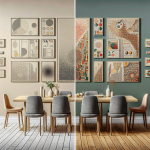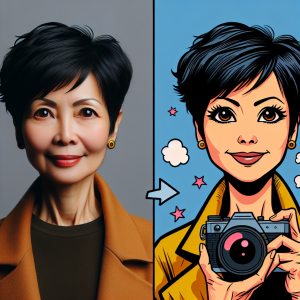Imagine scrolling through your social media feed and coming across a vibrant cartoon representation of a person you know—except their face is entirely absent. Instead, you see a swirl of colors, playful shapes, and clever design that speaks volumes about their personality. Welcome to the intriguing world of faceless portraits, where anonymity meets artistry in a delightful dance of creativity. This captivating form of expression not only respects privacy but also elevates the ordinary to the extraordinary. Let’s embark on a colorful journey exploring this fascinating art form!
The Birth of Faceless Art
Faceless cartoons have genuinely taken the art world by storm. But where did this quirky trend originate? The roots of faceless art can be traced back to traditional portraiture, where artists aimed to capture more than just physical likeness—they sought to express the subject’s essence. Over time, as privacy became more paramount in our increasingly digital lives, artists began experimenting with ways to convey narratives without revealing identities.
Why Faceless? The Allure of Anonymity
So, why create art without a face? There are several reasons that artists and subjects alike are drawn to faceless representations:
- Privacy Protection: In an age where sharing personal information seems second nature, anonymity can feel like a breath of fresh air. Faceless art allows individuals to enjoy artistic expression without relinquishing their identity.
- Focus on Expression: When the face is absent, the viewer is prompted to engage with the other elements of the artwork—colors, forms, and styles take center stage. This encourages a deeper emotional and intellectual connection.
- Universal Appeal: Faceless art can resonate with a broader audience. Without specific facial features, it allows viewers to project their interpretations and experiences onto the artwork.
- Emotional Resonance: The absence of facial expressions allows for a different type of storytelling. Without preset emotional cues, viewers must tap into their feelings and imaginations, creating a more personalized narrative.
Techniques and Styles in Faceless Art
The beauty of turning portraits into faceless cartoons lies in the variety of techniques and styles artists employ. Here are a few popular ones:
Minimalism Meets Whimsy
Minimalist approaches often feature simple lines and limited shapes to evoke a sense of playfulness. Artists utilize color and composition to convey personality without the need for intricate details. You might see a bright, oversized hat, a funky scarf, or vibrant shoes—elements that embody the subject’s vibe without showing their face.
Surrealism Unleashed
Some artists take a surrealist approach, combining unexpected elements that tell a richer story. Picture a character with oversized limbs surrounded by dreamy clouds, or perhaps an array of floating objects representing memories or passions. Surreal faceless art pushes boundaries and invites viewers to dive deeper into meaning.
Digital Magic
With technology at our fingertips, digital art has flourished tremendously. Artists utilize software like Procreate or Adobe Illustrator to create captivating faceless cartoons that play with layers, textures, and filters. Digital art often allows for more experimentation with styles and techniques, giving artists the freedom to express themselves in innovative ways.
How to Create Your Own Faceless Cartoon
Feeling inspired? Here’s a simple guide to help you create your own faceless cartoon:
Step 1: Choose Your Subject
Start by selecting a friend, family member, or even yourself as a subject. Consider their personality traits, interests, and style. Think about what colors or shapes would best represent them. This initial brainstorming is vital for the following steps!
Step 2: Sketch the Outline
Grab some paper or open your digital canvas. Begin by sketching a basic outline of your subject’s pose. Focus on exaggerating certain features like hair, clothing, or accessories while leaving out the facial details.
Step 3: Play with Colors and Patterns
This is where the magic happens! Choose a vibrant color palette that reflects the personality of your subject. Consider using playful patterns or textures to add depth to the artwork. Don’t hesitate to experiment—art is all about exploration!
Step 4: Add Personal Elements
Incorporate items that symbolize your subject’s hobbies or interests. If they love playing the guitar, include it in the piece. This not only personalizes the artwork but can also evoke emotions from those who know the individual.
Step 5: Finishing Touches
Once you’re satisfied with your design, take a step back. You might want to refine the outlines or add some final shading to enhance the look. Sign your piece and bask in the satisfaction of creating something unique!
Where to Share and Celebrate Faceless Art
Once your masterpiece is complete, you’ll want to share it with the world! Here are some great platforms for displaying your art:
Social Media
Instagram, Pinterest, and TikTok are fantastic platforms to share your faceless artwork. Use relevant hashtags like #FacelessArt or #CartoonPortraits to reach others interested in this style. Engaging with other artists and art enthusiasts can also offer inspiration and new perspectives!
Online Art Galleries
Websites like DeviantArt, ArtStation, and Behance enable artists to showcase their work in a professional manner. These platforms allow for direct interactions through comments and feedback, which can be incredibly valuable.
Art Exhibitions and Local Events
Don’t forget about local galleries or art fairs! Many communities host events that celebrate local artists. Exhibiting your work in person can be an exhilarating experience and allows you to connect with your audience directly.
Faceless Art in Popular Culture
Faceless art has made its mark in various aspects of popular culture. From animated series and social media illustrations to merchandise, more and more creators are embracing this whimsical and open-ended approach to portraiture.
Digital Commissions
Many artists are now offering digital portrait commissions that follow this faceless trend. It’s a fun way for individuals to own a personalized piece of art without revealing their likeness. Customers love the playfulness and creativity that faceless art brings!
Influence in Animation
Shows featuring animated characters often use faceless designs, allowing viewers to connect on a deeper level. Notable examples include characters from popular animated series where shape, color, and movement replace traditional facial expressions, lending a unique storytelling flair.
Merchandise and Fashion
Faceless art has also made its way into the world of fashion and merchandise. From T-shirts to tote bags, the playful designs resonate with a younger audience looking for something fresh and unconventional, thus solidifying faceless art as not just an art form, but also a lifestyle.
Conclusion: Embrace the Identity in Anonymity
The world of faceless cartoons is both enchanting and liberating. It offers a unique perspective on identity, allowing individuals to express creativity while maintaining a sense of privacy. So whether you’re an aspiring artist looking to dip your toes into this whimsical pool or simply someone enchanted by art, there’s a brilliant sense of freedom in embracing anonymity through expression. Why not take a moment to explore this fascinating trend and discover the stories waiting to be told without a single face in sight?
Frequently Asked Questions (FAQ)
What materials do I need to create faceless art?
You can use traditional materials like paper, pencils, paints, or markers. If you prefer digital art, software like Procreate, Adobe Illustrator, or free options like Krita are excellent choices to get started!
Can anyone create faceless art, or do you need special skills?
Absolutely anyone can create faceless art! The beauty of art is that it comes from personal expression. Skills can be developed over time, so don’t hesitate to try it, regardless of your level of experience!
Is faceless art only for professional artists?
No way! Faceless art is for everyone—from beginners to seasoned professionals. It’s all about self-expression and enjoying the process, so dive in and create!
How can I protect my faceless art online?
If you’re concerned about copyright, consider watermarking your art before posting or sharing it. You can also display lower-resolution images online while reserving high-quality images for prints or sales.
Where can I find inspiration for faceless portraits?
Platforms like Pinterest, Instagram, and ArtStation are treasure troves of inspiration. Follow artists who create faceless art, engage with communities, or participate in challenges to spark your creativity!
Can faceless art convey emotions?
Absolutely! Even without facial features, colors, shapes, and other elements can evoke various emotions. This art form often invites viewers to interpret the feeling based on their own experiences and perspective.








+ There are no comments
Add yours